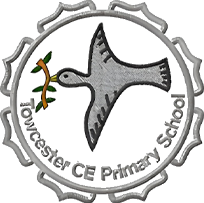Art
Intent
At Towcester C of E Primary School, we believe that Art is a vital part of children’s education. Our curriculum provides children with planned opportunities to develop their technical abilities, express themselves creatively in a range of media and develop their evaluative and critical abilities. Through the study of a diverse range of artists, our children develop their understanding of their own cultural heritage and that of others. Children will develop their understanding of the visual language of art with effective teaching delivered through considered sequences of lessons and experiences.
We aim to dedicate the necessary time and quality resources to facilitate learning
opportunities for our pupils. Our learning sequence develops pupils’ abilities to respond to a stimulus, to select visual elements and rehearse techniques in a process to produce high quality compositions and outcomes. This sequence also enables our pupils to understand that the perseverance and attentiveness needed to complete a piece of artwork leads to a sense of personal pride and satisfaction.
Implementation
Our Art curriculum delivers the objectives of the national curriculum and its programmes of study. Art is organised into a carefully sequenced, progressive long-term map of units which are taught in year groups throughout the academic year. Units comprise of the strands that run throughout our scheme of work and deliver essential knowledge and skills. These are:
- Generating ideas
- Using sketchbooks
- Making skills, including formal elements (line, shape, tone, texture, pattern, colour)
- Knowledge of artists (from different periods and cultures)
- Evaluation and analysis
Our curriculum mapping is drawn from the Trust’s progression documents which detail the essential knowledge that children should attain in Drawing, Painting, Printing, Collage, Textiles and 3D work in each year group. To ensure that pupils’ knowledge is progressive and relevant to their key stage, units of study containing focus knowledge and skill objectives are carefully mapped across the school in our Long Term Map.
Progression through different techniques is carefully sequenced into year groups to enable teachers to plan medium term units of work which build on and revisit prior knowledge enabling children to ‘know more and remember more’.
Key skills are revisited again and again with increasing complexity within and between year groups enabling pupils to revise and build on their prior learning. This systematic approach to the development of artistic skills means that children are given opportunities to express their creative imagination, as well as to practise and develop mastery in the key processes of art.
Our emphasis on knowledge of artists, vocabulary and technique ensures that children understand the significance and context of the artwork they study, as well as the artists that they are learning about and being inspired by. This also enables links to other curriculum areas, including humanities, with children developing their knowledge of individual artists as well as individual works and movements in art.
Sketchbooks provide a key resource in which pupils learn, explore, rehearse, practise and refine their artistic skills, ideas and creations; they capture each child’s learning journey.
Pupils are taught that their first idea may not be their best idea and that mistakes form an important part of the learning process – this learning is captured in sketch books as skills and ideas develop throughout each unit. Pupils develop resilience and perseverance through experimenting with ideas and processes in their sketchbooks; they are encouraged to take risks and to be ambitious.
Impact
The structure of the art curriculum ensures that children are able to develop their knowledge and understanding of the work of artists, craftspeople and designers from a range of times and cultures and apply this knowledge to their own work.
The consistent use of children’s sketchbooks means that children are able to review, modify and develop their initial ideas in order to achieve high quality outcomes. Children learn to understand and apply the key principles of art: line, tone, texture, shape, form, space, pattern, colour, contrast, composition, proportion and perspective. The opportunity for children to refine and develop their techniques over time is supported by effective lesson sequencing and progression between year groups. This also supports children in achieving age related expectations at the end of their cohort year.
Classroom displays reflect the children’s sense of pride in their artwork and this is also demonstrated by creative outcomes across the wider curriculum. The school environment also celebrates children’s achievements in art and demonstrates the subject’s high status in the school, with outcomes enhancing the environment.
The Art curriculum at Towcester contributes to children’s personal development in creativity, independence, judgement and self-reflection. Children will achieve age related expectations in Art at the end of their cohort year.
Documents
-
Art Curriculum Statement
download_for_offline
download_for_offlineArt Curriculum Statement
- Art Long Term Map download_for_offline
download_for_offlineArt Long Term Map
- Art Long Term Map download_for_offline

Peterborough Diocese Education Trust
PDET is a family of Church of England Schools across Northamptonshire, Peterborough and Rutland.
Visit Site





